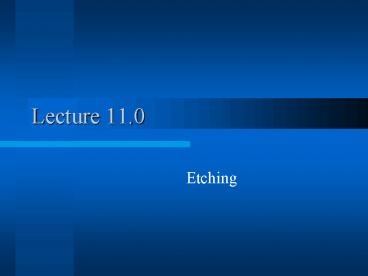Etching - PowerPoint PPT Presentation
Title:
Etching
Description:
Lecture 11.0 Etching Etching Patterned Material Selectivity is Important!! Un-patterned Etching Dry Etch An-isotropic dy/dt:dx/dt:6 Gas Phase Reaction with volatile ... – PowerPoint PPT presentation
Number of Views:126
Avg rating:3.0/5.0
Title: Etching
1
Lecture 11.0
- Etching
2
Etching
- Patterned
- Material Selectivity is Important!!
- Un-patterned
3
Etching
x
y
- Dry Etch
- An-isotropic
- dy/dtdx/dt6
- Gas Phase Reaction with volatile products
- Frequent use of very reactive species in a Plasma
- Si Etch
- SiO2 Etch
- Metal Etch
- Wet EtchDissolution
- Isotropic
- dy/dtdx/dt1.2
- Si Etch
- Strong HF
- SiO2 Etch
- Strong NH4OH not NaOH (Na ion is bad)
- Si3N4 Etch
- Phosphoric Acid
- Metal Etch
- Acid Solution (HNO3)
- Photoresist
- Solvent
- H2SO4 Solution
4
Etching
- Wet and Dry Etch have very different chemical
reactions! - Wet and Dry Etch have similar rate determining
steps - Mass Transfer Limiting
- Surface Reaction Limiting
- Similar mathematics
5
Wet Etch Chemistries
- Layer Etchant
- Photoresist H2SO4, H2O2
- SiO2 HF, NH4F-HCl-NH4F
- Si3N4 ?, HNO3
- Si HF
6
Dissolution of Layer-Wet Etch
- BL-Mass Transfer
- A(l)b B(s)?? ABb(l)
- A
- Acid for metal (B) dissolution
- redox reaction
- Base for SiO2 (B) dissolution
- Solvent for photoresist (B) dissolution
7
Etch Reactions
- Boundary Layer Mass Transfer
- Surface Chemical Reaction
- Like Catalytic reaction
- Product diffusion away from surface
Reactant Concentration Profile
Product Concentration Profile
8
Rate Determining Steps
X
9
Global Dissolution Rate/Time
- Depends on
- Mass Transfer
- Diffusion Coefficient
- Velocity along wafer surface
- Size of wafer
- Solubility
- Density of film being etched
10
Wet Etch Reaction
- Wafers in Carriage
- Placed in Etch Solution
- How Long??
- Boundary Layer MT is Rate Determining
- Flow over a leading edge for MT
- Derivation Mathcad solution
Also a ?C for the Concentration profile
11
Local Dissolution Rate/Time
- Depends on
- Mass Transfer
- Diffusion Coefficient
- Velocity along wafer surface
- Size of wafer
- Solubility
- Density of film being etched
- Position on the wafer
- see photoresist dissolution example
12
Dry Etch
- Physical Evaporation
- Not typically used
- Heating chip diffuses dopants out of position
- Sputtering from a target
- Plasma reactor with volatile reaction product
13
RF Plasma Sputtering for Deposition and for
Etching
RF DC field
14
Removal Rate
- Sputtering Yield, S
- Sa(E1/2-Eth1/2)
- Deposition Rate ?
- Ion current into Target Sputtering Yield
- Fundamental Charge
15
Plasma
- Free Electrons accelerated by a strong electric
field - Collide with gas molecules and eject e-
- Collision creates more free electrons
- Free electrons combine with ions to form free
radicals - Gas Ions/Free Radicals are very reactive with
materials at the wafer surface - Ions non-selective removal
- Free Radicals
16
Plasma Conditions
- Reduced Pressure 100 mtorr
- Flow of gases in and out
- DC or AC (rf) electric field
- Parallel plate electrodes
- Other geometries
17
Dry Etch Chemistries
- Gas Surface Etched
- O2 Pre-clean
- 95CF4-5 O2 Si
- 50CF4-25HBr-25O2 Poly Si
- 75Cl2-25HBr Metal etch
- CF2 layer on side walls prevents wall etching
18
Plasma
- Temperature of Gas molecules, Tgas ?PVm/Rg
- Temperature of Electrons,
- Te e2E2Mg/(6me2?m2 kB)
- Accelerated by E field between collisions with
gas molecules - ?m momentum collision frequencyNg vel ?m(v)
- Te ? E/Ng ? ERgTg/Ptot gtgt Tgas
- kBTe gt Gas Ionization Energy
- kBTe gt Molecular Dissociation Energy
19
Plasma Gas Chemistries
- Reactant Gases
- Physical Etch Sputtering from chip target
- Ar
- Chemical Etch
- O2
- CF4
- HBr
- Cl2
- CHF3
- C2F6
- Mixtures
- CF2 deposition (like a teflon polymer layer)
prevents side wall etch
20
Gaseous (Volatile) Products
- SiO(g), SiF4(v), SiCl4(v), SiBr4(v)
- MFx(v), MClx(v), MBrx(v),
21
1st Ionization Energies
- O 13.618 eV
- Br 11.814 eV
- Cl 12.967 eV
- F 17.422 eV
- H 13.598 eV
- Ar 15.759 eV
22
Plasma Etch Mechanism
- PreClean
- O2 e?O2 2e
- O2 e?2O e
- O e ? O-
- O2 e ? 2O
- O s ? O-s
- O Si(s) ?s-SiO
- SiO-s ? SiO(g)
- Metal (M) Etch
- Cl2 e ? 2Cl e
- Cl2 ? Cl2 e
- Cl s ? Cl-s
- x Cl-M(s) ? MClx(g)
- Simultaneously
- e CF4 ? CF3 F 2e
- e CF3 ? CF2 F
- CF3 CF2? (CF2)nF
- Polymer on wall of etch
Neutrals are main reactive species!!
23
Degree of Ionization, a
- a Ni/No Qi N ?D
- N neutral number density
- N NiNo
- ?D Characteristic Diffusion length (mean free
path) - Qi ionization collision cross section
- Qi 0.283 x 10-16(cm2) Pi(E)
- Pi(E) ionization probability
24
Plasma Transport Equations
- Flux, J
25
Etch Reactions
- Boundary Layer Mass Transfer
- Surface Chemical Reaction
- Like Catalytic reaction
- Product diffusion away from surface
Reactant Concentration Profile
Product Concentration Profile
26
Etch Reaction
- A(g)bB(s)?? ABb(g)
- -(1/A) dNB/dt -(1/A)(?/MwB)dVB/dt -(?/MwB)
dy/dt - JB - JB b JA b Kg(CAg-CAs) BL-MT of A
- JB b JA b ks Cag Surface Reaction
-
may be catalytic - JB b JABb Kg(CABb-s-CABb-g) BL-MT of Abb
- JB b q/?Hrxn
- q h (Ts Tg) BL-HT
- q k dT/dy Conduction in wafer
27
Rate Determining Steps
X
28
Plasma Etch Rate of Polymers
Residue Build-up
29
Plasma Etch Rate of Polymers
30
Clean developed Photoresist off of wafer
- Wet-chemical stripping agents (solvents)
- Incomplete wetting at small scale
- Supercritical CO2.-new technology
- Zero surface tension
- Complete wettability
- Good for small line widths































